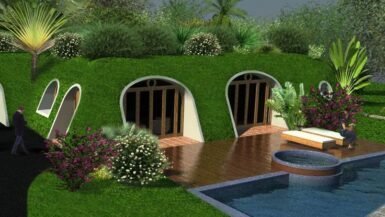As the sustainable living movement continues to gain momentum, an increasing number of individuals are considering the benefits of downsizing to a tiny home. In this article, we will explore the advantages of utilizing Structurally Insulated Panels (SIPs) in the construction of these eco-friendly abodes. SIPs, a highly efficient and durable building material, offer numerous benefits such as reduced energy consumption, improved insulation, and decreased construction time. By delving into the specifics of SIPs and their applications in tiny home construction, we aim to provide valuable insights for those seeking to make a positive environmental impact through their choice of dwelling. So, let’s embark on this journey to discover how SIPs can help create a more sustainable and efficient tiny home for a greener future.
Enhanced Energy Efficiency: SIPs Contribution to Tiny Home Sustainability
One of the most compelling reasons to choose SIPs for tiny home construction is their outstanding energy efficiency. These high-performance building panels significantly reduce energy consumption by providing superior insulation and thermal resistance. In this subsection, we will delve into the specifics of SIPs’ energy efficiency, highlighting their contribution to tiny home sustainability.
Reduced Thermal Bridging and Air Infiltration
SIPs consist of an insulating foam core sandwiched between two structural facings, typically made from oriented strand board (OSB). This design minimizes thermal bridging, which occurs when heat is transferred through the building’s structural elements, such as studs or joists. By reducing thermal bridging, SIPs effectively minimize heat loss and maintain a consistent indoor temperature, leading to lower energy consumption.
Additionally, SIPs create an airtight building envelope, preventing drafts and air leaks. This superior air sealing contributes to the overall energy efficiency of the tiny home, ensuring that heating and cooling systems work more efficiently and consume less energy.
Improved Insulation Values
SIPs offer impressive insulation values, with R-values (a measure of thermal resistance) that typically range from R-14 to R-26, depending on the thickness of the panel. This superior insulation allows for a more consistent indoor temperature, reducing the need for constant heating or cooling. As a result, tiny home occupants can enjoy lower energy bills and a reduced carbon footprint.
Optimal Energy Performance with Passive Solar Design
When combined with passive solar design principles, SIPs can further enhance the energy performance of a tiny home. Passive solar design involves strategically placing windows, doors, and thermal mass to maximize natural heating and cooling, reducing the need for artificial temperature control. SIPs, with their superior insulation and airtight construction, complement these passive solar strategies, ensuring that the tiny home remains comfortable and energy-efficient throughout the year.
Long-Term Sustainability Benefits
By significantly reducing energy consumption, SIPs contribute to the long-term sustainability of tiny homes. Not only do they help homeowners save on energy costs, but they also lessen the environmental impact of the dwelling. As the demand for sustainable living solutions grows, SIPs stand out as an innovative and effective way to create energy-efficient tiny homes that minimize our carbon footprint and promote a greener future.
Quick and Easy Assembly: Streamlining Tiny Home Construction with SIPs
In addition to the numerous energy efficiency benefits, the use of Structurally Insulated Panels (SIPs) in tiny home construction also results in a faster and more streamlined building process. This section will explore the various ways in which SIPs contribute to quick and easy assembly, enabling homeowners to move into their new, sustainable living spaces sooner.
Pre-Fabricated and Customizable Panels
One of the primary advantages of SIPs is that they are pre-fabricated, which means they are manufactured off-site and delivered ready for assembly. This not only reduces construction time but also ensures that each panel is made with precision, resulting in a high-quality final product. Furthermore, SIPs can be customized to suit the specific design requirements of each tiny home, providing flexibility in terms of layout and aesthetics.
Efficient On-Site Assembly
The assembly process for SIPs is relatively simple and straightforward, as the panels are designed to fit together seamlessly, much like a jigsaw puzzle. This streamlined construction method reduces the need for skilled labor and minimizes the potential for human error, ensuring a structurally sound and well-insulated tiny home. Moreover, the quick assembly time means that the building process is less susceptible to delays caused by adverse weather conditions, further contributing to the efficiency of SIP-based construction.
Reduced Waste and Cleanup
SIPs not only expedite the construction process but also contribute to a cleaner and less wasteful building site. Since the panels are pre-fabricated, there is minimal cutting and trimming required on-site, which means less waste material and debris. This not only reduces the time and effort needed for cleanup but also supports the overall sustainability goals of tiny home living by minimizing construction waste.
Integration of Electrical and Plumbing Systems
SIPs can be manufactured with pre-cut channels for electrical wiring and plumbing systems, further simplifying the construction process. This eliminates the need for extensive on-site work to accommodate these essential elements, saving both time and labor costs. As a result, the integration of utilities within the tiny home becomes more efficient and streamlined, contributing to the overall ease of assembly.
In summary, the use of Structurally Insulated Panels (SIPs) in tiny home construction leads to a quicker and more efficient building process. From pre-fabrication and customization to on-site assembly and utility integration, SIPs offer numerous advantages that streamline construction, allowing homeowners to start enjoying their sustainable living spaces sooner.
Superior Structural Strength: The Durability Benefits of SIPs in Tiny Homes
Structurally Insulated Panels (SIPs) not only provide remarkable energy efficiency, but also boast exceptional strength and durability. This subsection will explore the various ways in which SIPs contribute to the structural integrity of tiny homes, ensuring a long-lasting and resilient dwelling that stands up to the test of time.
Enhanced Load-Bearing Capacity
One of the key factors contributing to the superior structural strength of SIPs is their impressive load-bearing capacity. The unique design of SIPs, with the insulating foam core sandwiched between two structural facings, creates a continuous bond that distributes weight evenly across the panel. This results in a stronger, more stable structure capable of supporting greater loads than traditional stick-frame construction. In the context of tiny homes, this means a more robust dwelling that is better equipped to withstand the challenges of everyday living and changing environmental conditions.
Resistance to Natural Disasters
SIPs have been proven to provide enhanced resistance to various natural disasters, including hurricanes, tornadoes, and earthquakes. The airtight construction and superior load-bearing capacity of SIPs contribute to their ability to withstand high winds and seismic forces, providing tiny home owners with increased peace of mind. By choosing SIPs for their tiny home construction, homeowners can feel confident that their dwelling is not only energy-efficient and environmentally friendly, but also built to last.
Improved Moisture and Pest Control
Another durability benefit of SIPs is their ability to resist moisture and pests more effectively than traditional building materials. The airtight construction of SIPs helps to prevent moisture infiltration, reducing the likelihood of mold and rot developing within the tiny home. Moreover, the solid foam core of SIPs provides few opportunities for pests such as termites to infiltrate and cause damage to the structure. This increased resistance to moisture and pests contributes to the overall longevity and structural integrity of SIP-built tiny homes.
Minimal Settling and Structural Shifts
SIP-built tiny homes also benefit from minimal settling and structural shifts over time. The precision manufacturing of SIPs, coupled with their continuous bond, ensures that the panels fit together seamlessly, reducing the chance of gaps or weak points developing within the structure. This results in a more stable and secure tiny home that maintains its structural integrity over the long term.
To sum up, the use of Structurally Insulated Panels (SIPs) in tiny home construction offers a range of durability benefits that contribute to the long-lasting structural strength of these eco-friendly dwellings. From enhanced load-bearing capacity and resistance to natural disasters, to improved moisture and pest control, and minimal settling or structural shifts, SIPs provide tiny home owners with a resilient and reliable living space that can withstand the test of time.
Versatile Design Possibilities: Customizing Your Tiny Home using SIPs
Building a tiny home with Structurally Insulated Panels (SIPs) offers not only energy efficiency and durability but also a wealth of design possibilities. This flexibility allows homeowners to create a unique, personalized living space that meets their specific needs and preferences. In this subsection, we will explore the various ways in which SIPs can be customized to suit different design styles and requirements, ensuring that each tiny home is both functional and aesthetically appealing.
Flexible Floor Plans and Layouts
One of the key advantages of SIPs is their ability to accommodate a wide range of floor plans and layouts. The panels can be easily cut and shaped to fit the desired configuration, allowing homeowners to design a tiny home that maximizes the available space and meets their specific needs. This flexibility enables the creation of open-concept living areas, cozy sleeping lofts, and functional storage solutions, all within the confines of a compact footprint.
Adaptable Wall Heights and Roof Lines
SIPs also offer versatility in terms of wall heights and rooflines, allowing homeowners to create a tiny home with a truly unique aesthetic. Panels can be adjusted to accommodate varying wall heights, enabling the incorporation of features such as vaulted ceilings or split-level designs. Similarly, SIPs can be used to construct a diverse range of roof styles, from traditional gable roofs to more contemporary shed or butterfly roofs. This adaptability provides endless design possibilities for those looking to create a one-of-a-kind tiny home.
Seamless Integration of Windows and Doors
The customization potential of SIPs extends to the placement and sizing of windows and doors. Panels can be easily modified to incorporate various window and door configurations, allowing homeowners to optimize natural light and ventilation within the tiny home. This flexibility also enables the integration of unique design features, such as floor-to-ceiling windows or sliding glass doors, which can help to create a sense of spaciousness within the compact living space.
Exterior Finishes and Aesthetic Appeal
Finally, SIPs offer a range of exterior finishing options, allowing homeowners to personalize the appearance of their tiny home. The panels can be clad in a variety of materials, such as wood, metal, or fiber cement, to achieve the desired aesthetic. This versatility means that SIP-built tiny homes can be designed to blend seamlessly with their surroundings or to stand out as a distinctive architectural statement.
In summary, the use of Structurally Insulated Panels (SIPs) in tiny home construction offers a multitude of design possibilities, enabling homeowners to create a customized and visually appealing living space. From flexible floor plans and adaptable wall heights to seamless integration of windows and doors, and a wide array of exterior finishes, SIPs provide a versatile building solution that caters to the diverse needs and preferences of tiny home enthusiasts.
Cost-Effective Living: Long-Term Savings with SIPs in Tiny Home Construction
In addition to their energy-efficiency, durability, and design versatility, Structurally Insulated Panels (SIPs) offer significant long-term financial savings for tiny home owners. By reducing energy consumption, minimizing maintenance costs, and streamlining the construction process, SIPs contribute to a more cost-effective living experience. In this subsection, we will explore the various ways in which using SIPs in tiny home construction can lead to long-term savings and a more affordable, sustainable lifestyle.
Lower Energy Bills Through Superior Insulation
As previously discussed, SIPs provide excellent insulation and airtight construction, which translates to reduced energy consumption and lower heating and cooling costs. By maintaining a consistent indoor temperature and minimizing heat loss or gain, SIP-built tiny homes require less energy to keep their inhabitants comfortable. As a result, homeowners can expect to see significant savings on their monthly energy bills, contributing to the overall affordability of living in a tiny home.
Reduced Maintenance and Repair Costs
The durability and structural strength of SIPs also contribute to their cost-effectiveness by minimizing the need for ongoing maintenance and repairs. The resistance to moisture, pests, and natural disasters discussed earlier means that SIP-built tiny homes are less likely to require costly repairs or replacements over time. Additionally, the minimal settling and structural shifts associated with SIPs result in a more stable dwelling that is less prone to structural damage. These factors combine to reduce the long-term maintenance and repair costs for tiny home owners, further enhancing the affordability of this sustainable lifestyle choice.
Streamlined Construction Process and Labor Savings
The quick and easy assembly of SIPs, as well as their pre-fabrication and customization options, result in a more efficient and cost-effective construction process. This streamlined approach reduces the need for skilled labor and minimizes the potential for costly delays, which can lead to savings on labor and construction costs. By using SIPs in tiny home construction, homeowners can not only enjoy a quicker move-in timeline, but also benefit from the financial advantages associated with efficient and timely construction.
Increased Resale Value and Long-Term Investment
Lastly, the superior energy efficiency and durability of SIP-built tiny homes can contribute to an increased resale value, making them a sound long-term investment. Homebuyers are becoming increasingly conscious of the environmental impact of their living choices and are willing to pay a premium for homes that offer energy savings and reduced environmental footprints. By choosing to build with SIPs, tiny home owners can potentially increase the value of their investment, further adding to the cost-effectiveness of this sustainable living option.
In essence, building a tiny home with Structurally Insulated Panels (SIPs) offers numerous financial advantages that contribute to a more cost-effective and sustainable lifestyle. Through reduced energy bills, minimized maintenance and repair costs, streamlined construction, and increased resale value, SIPs provide tiny home owners with long-term savings and the opportunity to enjoy a more affordable, eco-friendly way of living.





Leave a reply